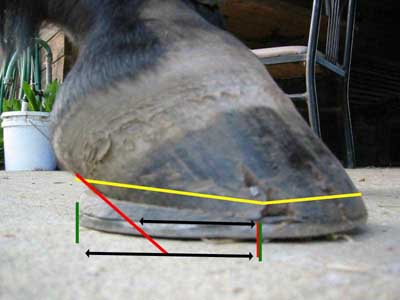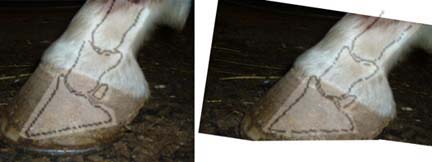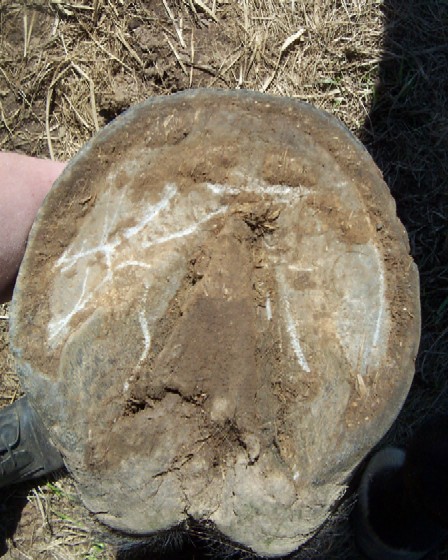Fran raises some interesting points. And, I would have to agree…to talk about obtaining optimal hoof form is easy and one thing…to actually do it, is another 
Even the most skilled farriers (especially the most skilled) will tell you that they rarely, if ever attain that optimal form, but that is the goal that they are always striving for. With the foot being a living, changing thing, fomulated by every change in body, management and environment, there is little that can be done to realize that “picture perfect”, optimal form. However, to ignore the benefits of attaining it, or write off the principles that guide us toward it, is to dismiss our duties as horseowners…but, its evident that’s why we are all here discussing this…because we all care and want to be better horseowners.
At most times during the year you can see my horses with toes to long, or heels to high, chips and some cracks where flares are being naturally removed…ok, so when you’re the farrier’s horses its hard to get an appointment! But, they don’t have underrun heels, or totally unbalanced, misaligned feet. They are generally barefoot and self-maintaining, so depending on the conditions of the ground and how overdo for a trim they are, at any time they may be looking anything but optimal…don’t actually have any that ever does look optimal…maybe one on trim day. But, they all ride anywhere sound, and that is, as Fran pointed out, an important issue.
But, they don’t have underrun heels, or totally unbalanced, misaligned feet. They are generally barefoot and self-maintaining, so depending on the conditions of the ground and how overdo for a trim they are, at any time they may be looking anything but optimal…don’t actually have any that ever does look optimal…maybe one on trim day. But, they all ride anywhere sound, and that is, as Fran pointed out, an important issue.
However, on that note, I would also remind everyone that lots of horses go sound for years in long toes,underrun heels with contraction, and misaligned, unbalanced feet…but I also see so many posts that ask why is my horse lame…he never used to be? Why do I need joint supplements, chiros, and massage for my horse at age 5-10? Why does my horse look old at age 10? Why does my horse stumble, interfer, refuse to jump, or perform certain moves? Why does he have wind puffs, tendonitis, or other worse things wrong with his legs? How did he get ringbone or navicular?
We also have lots of backyard trail horses in our area and farriers with anything but shinny trucks (some don’t even have trucks)…and horses that go everywhere sound. But, generally, the feet aren’t too bad looking…not sure how or why that happens…many of the shoers around here haven’t even been to school…maybe that’s why. They wouldn’t know optimal form if you asked them, they wouldn’t agree on how many nails or what size is optimal either. But, they are getting the job done and their customers like them, 'cause their horses walk away sound…never lame. But, they also don’t ask much of their horses either.
They wouldn’t know optimal form if you asked them, they wouldn’t agree on how many nails or what size is optimal either. But, they are getting the job done and their customers like them, 'cause their horses walk away sound…never lame. But, they also don’t ask much of their horses either.
So, there is a lot to be said for those who attempt to do a good job…realizing it or not…and those who just don’t “get it”. Regardless of if they “get it” or not, the majority of farriers are out there to help horses, not harm them and should be commended for their efforts. I, for one, would not get under a horse 5-7 days a week (not even 1) for a living…to much like work! 
Proud member of the * Hoof Fetish Clique *

 Anyway, he had trimmed the heel down, but left the toe really long so it looked like she was wearing a swim flipper. Then he proceeded to tell me that because she was going to be 2 this year that there was no hope. What happened in the weeks after that trim was disgusting. By the time I was able to get him back out - and I made him come back out just for her - the clubbed foot looked hideous. The last two times he has worked on her, he hasn’t even stopped to LOOK at her feet. He just does a little rasping and that’s it. Every time I tried to ask anything or get him to stop and LOOK he would just tell me that it’s “so hard” or “she’s too old now” or some other evasion
Anyway, he had trimmed the heel down, but left the toe really long so it looked like she was wearing a swim flipper. Then he proceeded to tell me that because she was going to be 2 this year that there was no hope. What happened in the weeks after that trim was disgusting. By the time I was able to get him back out - and I made him come back out just for her - the clubbed foot looked hideous. The last two times he has worked on her, he hasn’t even stopped to LOOK at her feet. He just does a little rasping and that’s it. Every time I tried to ask anything or get him to stop and LOOK he would just tell me that it’s “so hard” or “she’s too old now” or some other evasion 


